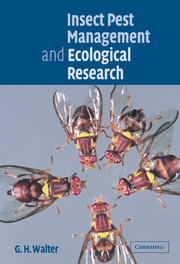Book contents
- Frontmatter
- Contents
- Preface
- Acknowledgements
- 1 Introduction
- Part 1 The place and nature of insect ecology research for IPM
- 2 Pest management as an applied science: the place of fact, theory and application
- 3 Historical trends in pest management: paradigms and lessons
- 4 IPM: a diverse, interrelated suite of socioeconomic and scientific problem-solving activities
- 5 An ecological underpinning for IPM
- Part 2 Specific directions in insect ecology research for IPM
- Part 3 Synopsis: Ecological research for IPM today
- References
- Index
3 - Historical trends in pest management: paradigms and lessons
Published online by Cambridge University Press: 22 August 2009
- Frontmatter
- Contents
- Preface
- Acknowledgements
- 1 Introduction
- Part 1 The place and nature of insect ecology research for IPM
- 2 Pest management as an applied science: the place of fact, theory and application
- 3 Historical trends in pest management: paradigms and lessons
- 4 IPM: a diverse, interrelated suite of socioeconomic and scientific problem-solving activities
- 5 An ecological underpinning for IPM
- Part 2 Specific directions in insect ecology research for IPM
- Part 3 Synopsis: Ecological research for IPM today
- References
- Index
Summary
Why did those entomologists most responsible for moving insect control toward less reliance on chemicals have such vastly different opinions about the research needs for their science?
j. h. perkins (1982, p. v)Introduction
Pest management poses many problems and they are diverse. Whereas some are scientific or technical in nature, others relate primarily to the development of policy or to the socioeconomic influences that impact on growers' needs and abilities. The relative mix of these various aspects has changed with time. Their combined end product, the general approach to dealing with pests, has consequently also changed. These changes are considered in this chapter, but only with reference to insects. Although no definitive history of pest management and its major influences has yet been written, many historical events have been documented, from as long as several thousand years ago (e.g. Ordish, 1976; Smith et al., 1973). The few critical analyses of important transitions in pest management that are available yield insights crucial to the ongoing development of theory and practice (e.g. Kogan, 1998; Perkins, 1982; Whorton, 1974).
Analytical historical reviews are beneficial. They help to identify ‘general guides for future action’ (Carr, 1987) and they alert us to how early interpretations influence our perception of reality (Sinclair & Solemdal, 1988). Through such investigation, for instance, we might identify a contemporary set of circumstances that had previously led to an undesirable outcome. Another such outcome could therefore be anticipated, which suggests pre-emptive measures be taken.
- Type
- Chapter
- Information
- Insect Pest Management and Ecological Research , pp. 44 - 71Publisher: Cambridge University PressPrint publication year: 2003



